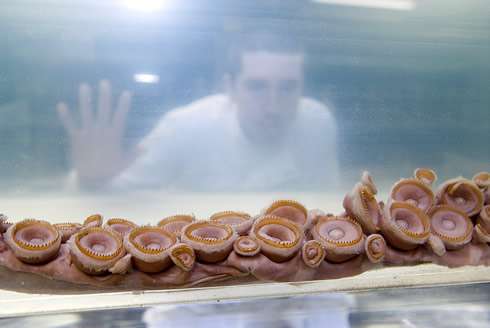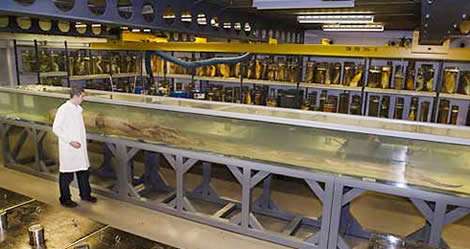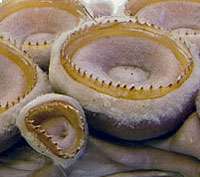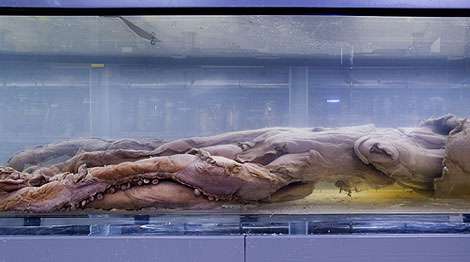Searching for more giant squid clues

The giant squid is a rare and elusive creature, once thought only to exist in tales of sea monsters called krakens.
Images, film and remains are extremely hard to obtain but the Natural History Museum's giant squid specimen, and the recent footage of a giant squid in its natural habitat, are adding to our knowledge of this amazing cephalopod.
The giant squid, Architeuthis dux, lives in the deep oceans at depths around 300 to more than 1000 metres. Deep-sea habitats are pretty unexplored, compared to habitats on land, or even the surface of the moon!
Although scientists are now discovering many new deep-sea creatures, the giant squid, which is thought to grow up to 14m in length, has stayed almost totally out of sight.
Most of what we do know about the giant squid is from remains found in the stomachs of sperm whales, or from dead or dying specimens washed onto beaches. Whole specimens are extremely rare which is one of the reasons the Museum's specimen, nicknamed Archie, is so important.

Archie was caught off the Falkland Islands in 2004 at 220m depth. It has 8 arms covered in teeth-filled suckers and 2 longer feeding tentacles, and reaches 8.62m in total length. Soon after it was named Archie, it was found to be a female. Unlike the males of squid species that live at shallower depths, the males of giant squid have an external penis that can be up to 1m long!
We know a lot about the anatomy of the giant squid but little about its behaviour or its life cycle.
New giant squid footage
Last month the first footage of a giant squid in its natural habitat was aired. It was recorded by a team off the shores of Japan at the end of 2012 and showed a squid estimated to be around 4m long. Marine biologist Edith Widder used an optical lure that mimicked the bio-luminescence of a live jellyfish to attract the predator - its 2 longer feeding tentacles were missing, perhaps lost from a fight with a sperm whale.
More footage, caught by Dr. Kubodera using a bait squid, revealed another animal and when the team shone a white light on it they were able to see its metallic silver and gold colour. The footage was taken at a depth of 700m.

What footage can reveal
Film can reveal much more useful information for scientists. 'The benefit of live footage is that we can see how it uses its body to move, hold itself in the water, feed and interact with the environment, something you can only guess at when looking at a dead specimen,' says Museum curator Jon Ablett who organised the preservation and storage of the Museum's giant squid specimen in 2004. As the largest fluid preserved specimen at the Museum, a container had to be built specially to hold it.

'The footage also suggests, as other images have, that the squid is a solitary species, not living in groups.'
Huge eyes
The footage also shows the huge eyes of the giant squid. They are the 2nd largest eyes of any animal on Earth, up to 27cm across or the size of a football. The largest eye of any living creature belongs to the colossal squid.
Good condition of Archie
Unlike most Museum squid specimens [is this correct or should it be 'most squid specimens'], Archie is very well preserved - this was helped by the fact that Archie was caught alive. Its body was complete and fresh and immediately frozen. Few other examples in the world are in such good condition.
Archie's good condition meant that viable tissue samples could be obtained before its body had decayed too badly. Archie's tissue has been sent all over the world for researchers to carry out molecular and DNA analysis that could reveal information about the species, its distribution, life history and more. Results from one of these studies are due out soon.
Future footage?
So, what would be the prize footage to capture in the future? Jon says film that shows any aspect of giant squid reproduction. 'I would like to see images of mating squid, of fertilisation, egg laying, hatching, larval development. All which are largely unknown.'
Hopefully, now that scientists have a better idea about how to capture footage of the giant squid in its natural habitat, we may be in store for a sequel or two, but we probably shouldn't hold our breath!
More information:
Explore the giant squid fact file.
See the giant squid in the Museum's tank room on a Spirit Collection Tour.
Provided by Natural History Museum




















